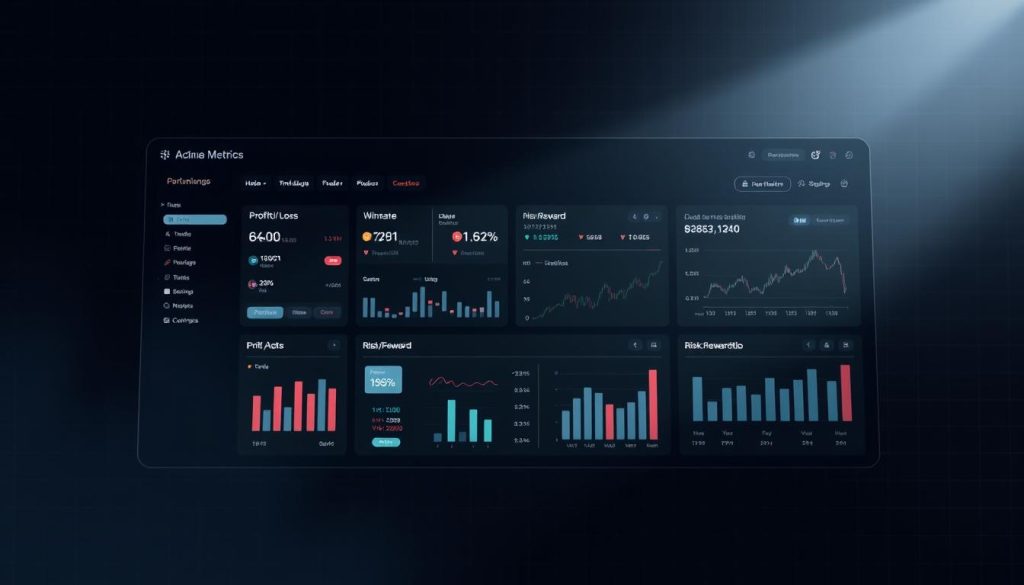How to Utilize Trading Journals to Enhance Performance in Prop Firm Challenges

Prop firm challenges need careful planning and tracking. Trading journals are key for traders aiming to boost their performance. They help increase success chances in tough evaluation settings.
Professional traders see trading journals as more than just notes. They are tools for deep analysis, turning trading data into useful insights. By logging trades, strategies, and emotions, traders spot patterns and flaws not seen in live trading.
Prop firm challenges require discipline and self-awareness. Trading journals help traders improve by breaking down their thought processes. This allows for precise strategy refinement.
Key Takeaways
- Trading journals are essential for performance enhancement in prop firm challenges
- Systematic documentation reveals hidden trading patterns
- Psychological insights can be gained through detailed trade recordings
- Performance tracking helps identify strengths and weaknesses
- Prop firm success relies on continuous self-evaluation
Understanding the Importance of Trading Journals in Prop Trading
Prop trading needs precision and self-awareness. Traders aiming for success must have strong tools for tracking and improving. Trading journals are key for those in the complex world of financial markets.
Trading journals turn raw data into valuable insights. They are more than just logs of transactions. They are tools for strategic growth.
Defining Trading Journal Purpose
A trading journal is a detailed performance tracker. It has several important roles:
- Document every trade with precise details
- Analyze market entry and exit points
- Capture emotional states during trading
- Identify recurring patterns in decision-making
Benefits of Systematic Recording
Systematic recording in prop trading offers clear insights into strategies. By logging trades carefully, traders can:
- Evaluate strategy effectiveness
- Measure risk management performance
- Detect potential improvement areas
Impact on Trading Psychology
“Self-reflection is the school of wisdom.” – Baltasar Gracián
Trading psychology is crucial for lasting success. Journals help traders understand their emotions, manage biases, and build discipline.
| Psychological Aspect | Journal Impact |
|---|---|
| Emotional Control | Reduces impulsive decisions |
| Self-Awareness | Highlights recurring behavioral patterns |
| Stress Management | Provides objective performance perspective |
Prop trading is all about learning and adapting. A well-kept trading journal is a treasure trove of knowledge. It turns experiences into strategic insights.
Essential Components of an Effective Trading Journal

Creating a good trading journal is more than just keeping records. It’s a key tool for traders to document and analyze their market actions. It needs careful focus on several important parts to really understand how well you’re trading.
Key parts of a good trading journal include:
- Trade Entry Details
- Specific entry price
- Market conditions
- Technical indicators triggering the trade
- Trade Exit Information
- Exit price
- Profit or loss amount
- Reasons for closing the position
- Risk Management Metrics
- Position sizing
- Stop-loss levels
- Risk-reward ratio
Understanding your emotions while trading is also key. Keeping track of how you feel helps you see how you make decisions. It’s important to note your stress, confidence, and mental state before, during, and after each trade.
“A trading journal is not just a record of transactions, but a mirror reflecting a trader’s strategic evolution.” – Professional Trading Mentor
Top traders see their journal as a tool for growth. By recording every trade, they can spot their good points, work on their weak spots, and trade smarter.
Digital vs. Manual Trading Journal Methods
Traders today face a big choice between digital trading journals and old-school manual methods. The rise of journal software has changed how traders keep track of their performance. It gives them powerful tools to improve their strategies.
Choosing the right method can greatly help a trader improve their strategies and reach their full potential. Digital trading journals offer big advantages in tracking and analyzing data.
Popular Trading Journal Software Options
- TraderVue: Advanced screen recording and trade analysis
- Tradersync: Comprehensive performance tracking
- Edgewonk: Detailed psychological and statistical insights
Customization for Different Trading Styles
Digital journal software is very flexible. Traders can change dashboards, create special performance metrics, and make detailed reports that fit their unique trading style.
Cost and ROI Analysis
| Journal Type | Monthly Cost | Features |
|---|---|---|
| Manual Journal | $0 | Basic tracking, limited analysis |
| Digital Journal Software | $20-$100 | Advanced analytics, automated reporting |
“The right trading journal can transform raw data into actionable trading insights.” – Professional Trader
Manual journals are simple, but digital ones offer deep analysis. Traders should think about their needs, budget, and how much tracking they want before choosing.
Setting Up Your First Trading Journal for Prop Firm Evaluation

Creating a good trading journal is key for success in prop firm evaluations. A well-organized journal helps traders keep track of their performance. It also lets them analyze their strategies and show consistency to potential prop firms.
Start your trading journal with these important parts:
- Trade entry and exit details
- Market conditions at the time of trading
- Emotional state during the trade
- Risk management parameters
- Specific prop firm evaluation metrics
For beginners, it might feel too much. The key is to start simple and gradually expand your tracking capabilities. Digital platforms make it easier to keep detailed trading records.
“A trading journal is your roadmap to consistent trading performance and prop firm success.” – Professional Trading Mentor
Digital tools make setting up your journal easier. They offer templates made just for prop firm evaluation. These tools automatically record important data, saving you from mistakes.
- Choose a digital or spreadsheet-based journal
- Define your tracking metrics
- Create a consistent logging routine
- Review and analyze your entries weekly
Prop firm evaluations need to be precise. Your trading journal is a powerful tool to show your discipline and strategic thinking. Spend time building a strong tracking system that shows your unique trading style.
Key Metrics to Track During Prop Firm Challenges
It’s key for traders to track the right performance metrics when facing prop firm challenges. Successful traders know that it’s more than just making profits. They track detailed performance indicators, risk management metrics, and emotional trading states. This helps them improve their trading strategy in a holistic way.

Effective performance tracking involves several critical components. These components give deep insights into trading behavior and areas for improvement.
Performance Indicators to Monitor
- Win rate percentage
- Average profit per trade
- Profit factor
- Total net profit
- Maximum consecutive wins/losses
Risk Management Metrics
| Metric | Description | Optimal Range |
|---|---|---|
| Maximum Drawdown | Largest percentage drop from peak to trough | Below 20% |
| Risk-Reward Ratio | Potential profit compared to potential loss | 1:2 or higher |
| Position Sizing | Percentage of capital per trade | 1-2% per trade |
Emotional Trading Documentation
Tracking emotional states during trading is crucial. Emotional trading can greatly affect performance. It’s important to document feelings like stress, confidence, and mental clarity.
“Understanding your emotional landscape is as important as understanding market trends.” – Professional Trading Analyst
By recording these key metrics, traders can turn data into strategies. This helps them do better in prop firm challenges.
How to Utilize Trading Journals to Enhance Performance in Prop Firm Challenges
Prop firm traders know that success is more than just trading skills. Using trading journals is key to doing well in prop firms. By keeping a detailed record of trades, traders can gain deep insights into their performance.

- Detailed trade documentation
- Quantitative performance metrics tracking
- Psychological state recording
- Pattern recognition analysis
“A well-maintained trading journal transforms raw data into actionable intelligence” – Professional Trading Strategist
Traders can get the most out of their journals by following a structured plan. Here’s a strategic framework to help improve performance in prop firms:
| Journal Strategy | Performance Impact |
|---|---|
| Comprehensive Trade Logging | Identifies repeatable success patterns |
| Emotional State Tracking | Minimizes psychological trading errors |
| Risk Management Documentation | Enhances consistent trading discipline |
Keeping a consistent journal practice turns trading into a proactive strategy. By recording every trade’s details, emotions, and market conditions, traders gain a deep understanding of their performance.
Prop firm traders who use journals well create a powerful learning loop. This method helps them learn, refine strategies, and improve performance in various trading challenges.
Analyzing Trading Patterns Through Journal Data
Successful prop traders know that analyzing trading patterns is key to getting better. A detailed trading journal turns raw data into useful insights. It helps traders understand their market actions and financial choices.

To do effective trading pattern analysis, you need a clear plan. By carefully recording each trade, traders can spot patterns. These patterns show both the good and bad sides of their trading strategy.
Identifying Profitable Setups
Finding profitable setups is essential for steady trading success. Traders should look for certain traits in their best trades:
- Market conditions during winning trades
- Entry and exit point precision
- Risk-to-reward ratios
- Psychological state during high-performance trades
Recognizing Costly Mistakes
Spotting mistakes is crucial for trading growth. By studying losing trades, traders can find patterns that cause losses:
| Mistake Category | Potential Impact | Mitigation Strategy |
|---|---|---|
| Emotional Trading | High Loss Potential | Implement strict trading rules |
| Overtrading | Capital Erosion | Set daily trade limits |
| Ignoring Risk Management | Significant Account Drawdown | Use consistent position sizing |
“The key to trading success is emotional discipline. If intelligence were the key, there would be a lot more rich intellectuals.” – Victor Sperandeo
By spending time on detailed trading pattern analysis, prop traders can turn their journal into a powerful tool. It becomes a key for ongoing improvement and strategy enhancement.
Implementing Journal-Based Strategy Refinements
Data-driven trading needs a clear plan for improving strategies. Traders who use their journals can turn data into useful insights. These insights help them keep getting better.
For effective strategy improvement, a careful analysis and adaptation process is key. Top traders know that their performance is always changing. They need to keep checking and adjusting their strategies.
“Improvement is not about being perfect, but about making consistent, incremental progress.” – Professional Trading Wisdom
Strategy Refinement Steps
- Analyze journal entries for recurring patterns
- Identify specific trade execution weaknesses
- Develop targeted improvement strategies
- Implement small, measured changes
- Track results with precise documentation
Improvement in trading needs a scientific approach. Each journal entry becomes a data point. This helps traders understand their trading psychology and how they execute trades.
Critical Refinement Metrics
- Win rate percentage
- Average reward-to-risk ratio
- Maximum drawdown
- Consistency of performance
Data-driven trading turns gut feelings into a clear plan. By carefully reviewing and improving strategies through detailed journaling, traders can create stronger and more flexible trading methods.
Using Trading Journals for Risk Management
Risk management is key to successful trading, especially in prop firm challenges. Trading journals help traders track and improve their risk strategies. They document trading decisions, offering insights into risk and performance.
Good risk management isn’t just about guessing. It needs a clear plan for analyzing strategies.
Position Sizing Documentation
Position sizing is vital for managing risk. A detailed trading journal helps track position sizing:
- Record the exact percentage of capital risked per trade
- Document the reason behind each position size choice
- Analyze how different strategies have performed
“Consistent position sizing is the hallmark of a disciplined trader.” – Professional Trading Mentor
Stop Loss Adherence Tracking
Stop loss adherence is crucial for protecting capital. Trading journals help track stop loss implementation:
- Document each trade’s stop loss level
- Compare actual exit to planned stop loss
- Calculate savings from strict stop loss discipline
Recording stop loss adherence helps traders spot emotional patterns. This leads to better risk management.
| Risk Management Metric | Tracking Method | Goal |
|---|---|---|
| Position Size | % of Total Capital | Consistent Risk per Trade |
| Stop Loss | Predetermined Exit Point | Capital Preservation |
Traders who use journals for risk management can change from reactive to proactive. This improves their performance in prop firm challenges.
Psychological Benefits of Regular Journal Reviews
Trading psychology is key to prop trading success. Regular journal reviews help traders reflect and control their emotions. They can see how their past trades reveal their decision-making and emotional patterns.
Regular journal reviews offer many psychological benefits:
- Develops emotional resilience
- Enhances self-awareness
- Reduces impulsive trading decisions
- Builds confidence through structured analysis
“Self-reflection is the school of wisdom.” – Baltasar Gracián
To make journal reviews effective, traders need a strategic plan. They should look for emotional triggers that affect their trading. Emotional control improves when you know your psychological patterns.
| Psychological Aspect | Impact on Trading | Review Strategy |
|---|---|---|
| Fear | Prevents risk-taking | Analyze risk management decisions |
| Overconfidence | Leads to excessive trading | Review position sizing |
| Patience | Improves strategic thinking | Examine trade entry/exit points |
Using a structured review process turns your trading journal into a tool for psychological growth. By regularly analyzing your trades, you create a cycle of improvement. This enhances your trading psychology and performance.
Leveraging Journal Data for Prop Firm Interview Preparation
Prop firm interviews are key moments for traders to show off their skills. Your trading journal is a strong tool to prove your expertise during these important talks.
To ace prop firm interviews, you need to show your trading consistency and risk awareness. Your detailed trading journal proves your trading approach and analytical skills.
Demonstrating Trading Consistency
Trading consistency is key to impressing prop firm recruiters. Your journal should show your disciplined trading:
- Consistent trade execution patterns
- Systematic entry and exit strategies
- Documented performance metrics
- Proof of sustainable trading methodology
“Your trading journal is not just a record, it’s your professional narrative.” – Professional Trading Mentor
Showcasing Risk Awareness
Risk management is crucial in prop firm interviews. Your journal shows your advanced risk management skills through:
- Detailed risk-per-trade documentation
- Consistent stop-loss implementation
- Position sizing strategies
- Emotional state tracking during trades
By presenting your trading journal data wisely, you turn prop firm interviews into chances to show your trading skills.
Common Trading Journal Mistakes to Avoid
Traders often make mistakes in their journals that can hurt their tracking and planning. It’s key to know these common errors to keep data right and avoid too much analysis.
To spot journaling mistakes, traders need a clear way to write and think about their actions. They must watch out for errors that mess up their analysis.
- Inconsistent Entry Practices
- Excessive Emotional Interpretation
- Neglecting Quantitative Data
- Overcomplicating Journal Structures
Keeping data accurate is vital for good trading journals. Traders often make the mistake of reporting too much from their feelings, which can mess up their insights.
“A trading journal is only as valuable as the precision of its data.” – Professional Trading Mentor
Another big problem is overthinking every detail. This can stop traders from making quick decisions.
| Mistake Type | Impact | Prevention Strategy |
|---|---|---|
| Inconsistent Logging | Incomplete Performance Tracking | Standardize Entry Template |
| Emotional Bias | Distorted Decision Making | Objective Metrics Tracking |
| Over-complicated Journaling | Reduced Journal Usage | Simplify Documentation Process |
Good traders keep their journals simple yet detailed. By avoiding these mistakes, they turn their journals into tools for getting better.
Advanced Journal Analysis Techniques
Experienced traders know that success in trading is more than just keeping records. Advanced analysis turns simple journal data into deep insights. These insights can greatly boost trading performance.
Exploring statistical methods requires a careful strategy. Traders can find hidden patterns and connections that simple analysis misses.
Statistical Analysis Methods for Trading Journals
Effective advanced analysis uses several complex techniques:
- Regression analysis to spot trading strategy strengths
- Correlation coefficient calculations for market trends
- Variance analysis of trading performance metrics
Performance Correlation Studies
Performance correlation studies help traders see how different trading factors connect. By looking at data points together, traders can:
- Find subtle performance clues
- Measure how well risk management works
- Refine their trading strategies
“Numbers tell a story – your job is to listen carefully.” – Professional Trading Insight
Advanced journal analysis uses data visualization tools and statistical software. This turns raw data into useful information. Traders can now make decisions based on solid math, not just gut feelings.
The aim of advanced analysis is to understand trading performance deeply. It’s not just about recording trades.
Integrating Journal Insights with Prop Firm Requirements
Understanding prop firm rules is key. Traders need a detailed system that fits trading parameters and tracks compliance. This system should show both technical skills and risk management.
- Precise tracking of individual trade performance
- Documenting risk management strategies
- Capturing psychological insights during trading
- Maintaining transparent compliance records
“A well-maintained trading journal is your passport to prop firm success.”
Prop firm challenges require careful attention to rules. Traders must go beyond simple records. The journal is a tool for showing consistent performance and following rules.
| Compliance Element | Tracking Method | Importance |
|---|---|---|
| Maximum Drawdown | Daily Portfolio Analysis | Critical Risk Management |
| Profit Targets | Cumulative Performance Metrics | Evaluation Requirement |
| Risk-to-Reward Ratio | Trade-by-Trade Evaluation | Consistent Strategy Validation |
Successful prop firm candidates know compliance tracking is more than following rules. It’s about showing a smart trading approach. Your journal should show careful risk-taking, strategic decisions, and growth.
By adding deep insights and keeping detailed records, traders can turn their journals into powerful tools. These tools show their real trading abilities.
Conclusion
Trading journals are key for traders wanting to get better in prop trading. They help by recording trades, spotting patterns, and tracking emotions. This way, traders gain insights that help them make better decisions and manage risks.
Keeping a trading journal does more than just log trades. It helps traders understand their own habits, find their strengths, and work on their weaknesses. Every trade is a chance to learn, turning mistakes into valuable lessons.
Success in prop trading comes from hard work and self-improvement, not luck. Using a good trading journal takes dedication, but it pays off big time. Traders who put in the effort to document and analyze their trades can greatly improve. This makes them more appealing to prop firms and boosts their chances of success.
Using a trading journal is not just a good idea—it’s essential for serious traders. Begin your journaling today. It will help you move from reacting to trading to making proactive, strategic moves. This is the first step towards lasting success in proprietary trading.
FAQ
What is a trading journal and why is it important for prop firm challenges?
A trading journal is a detailed record of all trading activities. It helps traders track their performance and improve their decision-making. For prop firm challenges, it’s key to show a systematic approach, risk management, and consistent trading methodology.
How often should I update my trading journal?
It’s best to update your trading journal right after each trade. This way, you can record trade details, emotional state, and market conditions accurately. It’s important to do this while the information is still fresh in your mind.
What key metrics should I track in my trading journal?
Key metrics include your win rate, average profit/loss, and risk-reward ratio. Also, track your maximum drawdown, position sizing, entry and exit points, and market conditions. Don’t forget to note your emotional state during each trade.
Are digital or manual trading journals better?
Digital journals offer automatic data tracking and analysis tools. They are easy to store. Manual journals provide a personal, reflective approach. The choice depends on your trading style and preferences.
How can a trading journal help improve my trading psychology?
A trading journal helps identify emotional patterns and biases. It helps develop disciplined trading behaviors. By documenting emotional states and analyzing their impact, traders can maintain emotional control.
What software is recommended for digital trading journals?
Recommended software includes TraderVue, Edgewonk, and MyTradeLog. These platforms offer tracking, performance analysis, and customization for different trading styles.
How detailed should my trading journal entries be?
Entries should be detailed but concise. Include trade details like instrument, entry/exit points, and position size. Also, note the reason for the trade, market conditions, emotional state, and post-trade analysis.
Can a trading journal help me pass prop firm challenges?
Yes, a well-maintained trading journal can improve your chances of passing prop firm challenges. It shows consistent strategy, disciplined risk management, and ability to learn and adapt.
How long should I maintain a trading journal?
Traders should keep a journal indefinitely. Long-term documentation allows for comprehensive analysis and continuous improvement of trading strategies.
What are the most common mistakes in maintaining a trading journal?
Common mistakes include inconsistent entries and lack of detailed analysis. Not being honest about emotional states and overlooking small details are also mistakes. Failing to review and learn from past trades is another error.
Prepare for a prop firm evaluation
